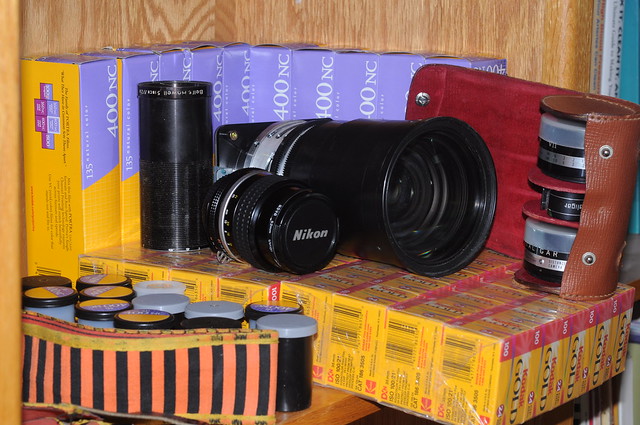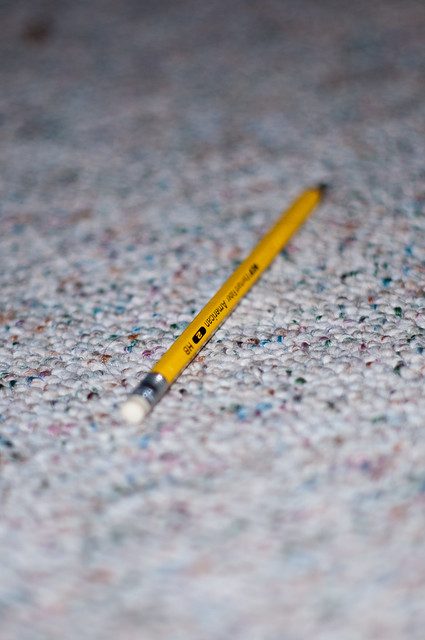Forums › Forums › Farktography General Chat › Farktography Pub and Grill › Another solid haul
- This topic has 11 replies, 9 voices, and was last updated 12 years, 2 months ago by
sleeping.
-
AuthorPosts
-
February 4, 2012 at 11:56 pm #2583
 orionidParticipant
orionidParticipantThe haul from the Richmond, VA Hamfest (Ham Radio based flea market):

The haul by Orionid, on FlickrNikkor 85mm f/2 (Now I have a portrait lens, yay!) with 102 rolls of freezer-kept 35mm – $50
Kaligar auxiliary lenses: wide, tele, and viewfinder, still new in original packaging – $5
Bell and Howell 5″ f/2.8 projector lens – $Free
An unknown lens from a 70mm movie camera (no markings on the mount or lens body) – $15
A well-worn but still functional and neat-looking neck strap – $2At wide open, the sweet spot in the 85mm is extra crispy and razor-thin:

Tack-sharp and Razor-thin by Orionid, on FlickrFebruary 5, 2012 at 2:37 am #45128ravnostic
ParticipantAh…you make me want to go out fleamarkteting again!
February 7, 2012 at 6:54 am #45129soosh
Participantit’s a really good thing that the nearest flea market is 900 miles away from me.
February 7, 2012 at 11:52 am #45130Yugoboy
ParticipantWithout wanting break anything, can I attach non-digital lenses to my Nikon? If so, which ones? My wife and I go flea marketing pretty regularly, and if I could pick up some tubes and telephotos and the like for the prices I can pay there, I’d be all about it.
I’ve been pretty leery of doing anything too non-conventional, as there is no budget for replacing anything. Once it’s gone, I gotta let it go, ’cause it’s gone.
February 7, 2012 at 1:21 pm #45131 orionidParticipant
orionidParticipantUsing lenses not intended for Nikons generally requires some sort of surgery, as nikon has one of the deepest flange focal distances of all the smaller-than-medium-format body manufacturers (Wiki). Using old Nikon lenses depends on your body (Handy chart).
Basically, never use a pre-AI lens on your dSLR body (Most say “Nippon Kogaku Japan” instead of Nikon. from 1971 to 1978, however, it’s a little harder to tell the difference. Click on the photo above to go to the flickr page, then click Actions–>View All Sizes. On the lower left (in the lens’s current orientation) is a silver prong attached to the aperture ring. That’s your best bet for determining pre/post AI. If the prong on the aperture ring has holes in it and there’s a ridge along the back of the aperture ring, it’s probably AI, if the prong is solid, it’s pre-AI. There’s a select few manual AI lenses that will damage a modern SLR because the rear casing will scratch or break your body’s AF contacts. The only one I know of offhand is the 28mm f/3.5 PC (tilt-shift). You can have a good camera shop professionally convert a pre-AI lens to AI or AIS (but is the juice really worth the squeeze at that point?), so long as it’s not one of the lenses with clearance issues.
Anything AIS or newer/better will at least work in full manual mode.
Edit to add everything below this point:
Disclamer: Ken Rockwell is a Douchebag and I usually hate every bit of dribble that froths out of his mouth, but what he has to say about the Series E lenses is spot-on.
Up through the 1970s Nikon only made very expensive professional lenses. Normal people had to buy discount brands lenses if they wanted something they could afford. Buying an off-brand lens was, and still is, the worst of all worlds: spending a lot on a camera, and then getting a dinky lens. The lens is the only part that affects the picture quality, so you are far better of with a crummy camera and good lenses.
To capture more of the amateur market Nikon decided to make a series of lenses called “Series E” which had great optical quality. They were built with well thought out, simple to manufacture optics and cheaper mechanics that were more than good enough for amateur use. These cheaper mechanics are often better than what Nikon makes today in some of their cheaper plastic AF lenses.
The optics are all great. Nikon only made Series E lenses in focal lengths and aperture ranges for which optics could be designed simply and still give great performance. For instance, I have the 100mm f/2.8E. A 100mm f/2.8 lens is very easy to make work very well for very little money. It is as sharp or sharper than my expensive 105mm f/2.8 AFD micro and 80-200mm f/2.8D AF-S especially at f/2.8. An 80-200mm f/2.8 zoom has to be expensive because it requires complex optics, but a fixed 100mm f/2.8 lens is easy to make inexpensively. Take these series E lenses very seriously.
The simplest Series E lenses were single-coated and others were multi-coated. Nikon’s designers knew what they were doing: they used whatever they needed. The very simple classic designs of some of the fixed focal length Series E didn’t need multi-coating.
The first Series E were a little bit ugly. The first were mostly black (lacking the chrome colored grab rings of the Nikkors) and used dorky big blocky nubs on the focus rings. In a few years Nikon updated the cosmetics and added the silver colored aluminum grab ring near the aperture ring and nicer looking nubs on the focus ring rubber, making them look very similar to the Nikkors.
These great lenses were never popular because Nikon was too honest.
Back then Nikon admitted that they used a little plastic here or there in the Series E lenses, which at the time was considered a crime. Remember everything is made of plastic today but back then everything was metal and weighed a ton. Nikon didn’t use the Nikkor brand name because they were reserving the Nikkor brand only for what they considered professional lenses. Therefore everyone was afraid of the Series E lenses and few people bought them. Oddly, more people bought the crummier cheap brands that weren’t as honest about what they were selling. Too bad, because the Series E were great lenses and far better than the discount ones. Today most Nikon AF lenses are far more cheaply made than the Series E were, and they are called Nikkor. Heck, even some of the super-expensive AF-S lenses have PLASTIC filter threads, and the Series E were solid metal.
From what I’ve seen Series E lenses typically had anodized black aluminum barrels and focus helicoids instead of enameled brass barrels and brass helicoids as the manual focus Nikkors do. All Series E had metal mounts, although some had plastic focus helicoids. They had aluminum zoom cams. Today’s cheap AF Nikkors have plastic mounts and very little metal anywhere. The Series E have plastic aperture rings, a crime in their time but standard on almost every expensive Nikon lens today. The series E were very precisely made mechanically.
Some Series E optical designs were used in newer AF-Nikkor lenses. For instance, I read that the first 28mm f/2.8 AF and AF-D Nikkor sold up until about 2001 was the Series E five element design, and that the 70-210 f/4 AF was the 70-210 Series E design.
The Series E retained Nikon’s superior seven-bladed diaphragms.
All Series E lenses are AI-s, and likewise fit every Nikon SLR camera, manual and auto focus. Some of the cheaper AF cameras and the D100 lose the ability to meter with the Series E as they do with all manual focus lenses.
See more about use on AF cameras here. The operation and compatibility of the Series E lenses is identical to the other manual focus AI-s lenses, which makes sense because they are AI-s.
In 2007, Nikon is re-using the E designation to refer to the electronic diaphragm of their PC-E lenses.
February 7, 2012 at 3:37 pm #45132Barracuda
ParticipantI believe the 85mm is the same as my dad has for his Nikkomat 35mm, and have seen some portraits my dad did of me as a 3-4 year old with it. Very nice glass. I expressed interest in acquiring the camera, 85mm and the Nikon 300mm from him since it’s probably been 15+ years since he’s last used any of it. I did buy a EOS-Nikon adapter to see how the two play with my XSi. Sad that it’s harder to get old Nikon glass on new Nikon bodies than a Canon body.
February 7, 2012 at 4:49 pm #45133sleeping
ParticipantBasically, never use a pre-AI lens on your dSLR body.
This depends on the body now. The new lower-end cameras which only support metering with G lenses (D3000 etc) can mount most non-AI lenses unmodified.
You can have a good camera shop professionally convert a pre-AI lens to AI or AIS (but is the juice really worth the squeeze at that point?), so long as it’s not one of the lenses with clearance issues.
It’s actually not very complicated to do, you just have to create enough clearance for the aperture feeler (the little lever next to the lens mount that detects if a non-G lens is set to minimum aperture).
http://www.chr-breitkopf.de/photo/aiconv.en.html
But unless you’re going to use it on a film camera or a higher-end model that supports AI metering, you don’t need to worry so much about determining the correct indexing he describes there, you just need clearance for the feeler.
Just don’t do it to anything with any collecting value….
February 7, 2012 at 5:15 pm #45134fluffybunny
ParticipantAhhh yes, one of the very reasons I heart my Canon. I can use old Nikon lenses with little more than a $20 brass adapter.
A few of my favorites (either Nikon or M42 mounts):
Soligor 135mm f2.0 prime
Vivitar Series 1 90mm f2.5 macro with matching tube (came with the protective peel away sheeting on the aluminum)
Micro-NIKKOR 55mm f2.8 macro
NIKKOR-O 35mm f2 primeFebruary 7, 2012 at 5:20 pm #45135Yugoboy
ParticipantThat’s a LOT to remember!
Gonna have to print that out before flea market season.So, I guess i should stick to the Nikon or Nikkor brands if I don’t have paperwork specifically addressing compatibility?
February 7, 2012 at 7:47 pm #45136Farktographer
ParticipantThat’s a LOT to remember!
Gonna have to print that out before flea market season.So, I guess i should stick to the Nikon or Nikkor brands if I don’t have paperwork specifically addressing compatibility?
Unless you find something cheap enough that it wouldn’t matter if you broke it (NOT your camera) in trying to get it to fit properly, I’d say that sounds about right.
February 8, 2012 at 1:04 am #45137Yoyo
ParticipantAs much difficulty that there may be in fitting old Nikon lenses to modern bodies, the Canon FD mount won’t fit on the EF bodies either. The old register distance was 42mm and the EOS is 44mm, so unless you can sink the classic 50mm f/0.95 into your body by 2 inches, you’re out of luck. Now on a 4/3s…
February 8, 2012 at 1:37 am #45138sleeping
ParticipantSo, I guess i should stick to the Nikon or Nikkor brands if I don’t have paperwork specifically addressing compatibility?
All the terminology is a bit arcane, but it’s actually pretty simple to tell if a lens is compatible by just looking at the aperture ring. I put a post in the hardware forum with the details.
the Canon FD mount won’t fit on the EF bodies either. The old register distance was 42mm and the EOS is 44mm, so unless you can sink the classic 50mm f/0.95 into your body by 2 inches, you’re out of luck.
Actually, the 50/0.95 was a rangefinder lens that only mounts to a special flange on the Canon 7 (they can be modified to Leica M or C mount though)
http://www.canon.com/camera-museum/camera/lens/s/data/50-85/s_50_095.html -
AuthorPosts
- The topic ‘Another solid haul’ is closed to new replies.